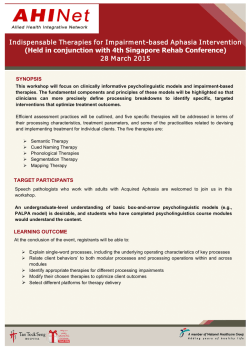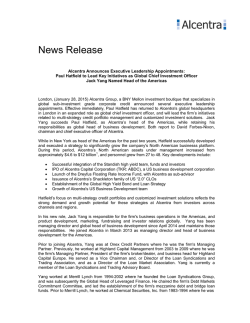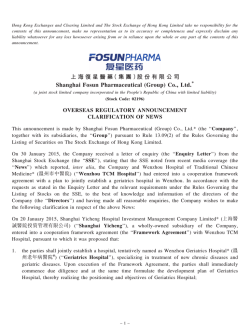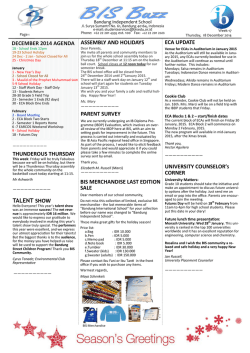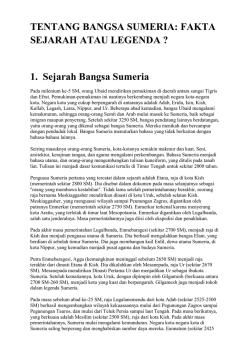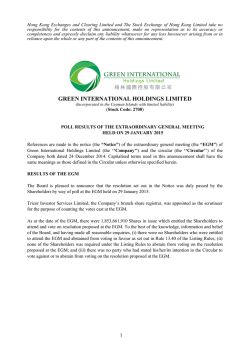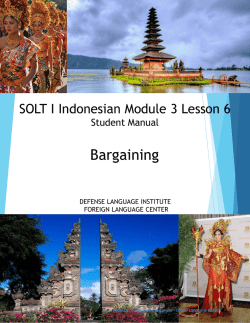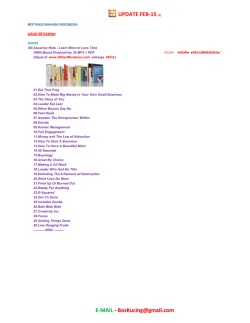
Prof. Dr. Amani S. Awaad Pharmacognosy
Pharmacognosy- 1 PHG 222 Prof. Dr. Amani S. Awaad Professor of Pharmacognosy Pharmacognosy Department, College of Pharmacy Salman Bin Abdulaziz University, Al-Kharj. KSA. Email: [email protected] To know Traditional Systems of Herbal Medicine To Recognize what is Complementary and alternative medicine To Identify complementary medicine To Identify alternative medicine To differentiate between all types of alternative medicine Complementary and alternative medicine Traditional Systems of Herbal Medicine Definition • Medical practice that includes diagnosis, prevention and treatment, relying on practical experience and observations handed down from generation to generation whether verbally or writing. It is necessary for pharmacists to know about basic principles of traditional medicine for two reasons: 1- To be in a position to advise patients who may wish to consult an alternative practitioner. 2- Traditional use is a common starting point in the ongoing search for new drugs. Traditional Systems of Herbal Medicine The Dose Traditional Medicine (TM), usually means a lack of specific dose, it is more concerned with How to take the remedy rather than How much So, highly potent plants are rarely part of a traditional medicine pharmacopoeias. e. g. Digitalis purpurea a drug used in treatment of congestive heart failure with narrow therapeutic index of the drug. The Diseases in Traditional Systems are Classified into I- Minor or Self-Limiting Disorders Like aches, pain, flatulence, diarrhea, wounds and facilitating childbirth, for which plant or herb can be obtained from a local market and would be well known within the community. II- Chronic or Serious Disorders Like cancer and some genetic or metabolic diseases Plant remedies will certainly be used but they may be used as a part of a ritual and treatment will also involve practices such as divination to find out which gods or ancestors have been offended and what sacrifices may be necessary to appease the supernatural entity Complementary and alternative medicine Complementary and alternative medicine,” “complementary medicine,” “alternative medicine,” “integrative medicine what do they really mean? hard to define and may mean different things to different people Complementary and alternative medicine What are the major types of complementary and alternative medicine? NCCAM (National Center for Complementary and Alternative Medicine) classifies CAM therapies into five categories, or domains 1. 2. 3. 4. 5. Alternative Medical Systems., or complete systems of therapy and practice. e.g. Traditional Chinese Medicine and Ayurveda Mind-Body Interventions. or techniques designed to facilitate the mind's effect on bodily functions and symptoms. e.g. prayer, meditation, art, music, or dance. Biologically Based Therapies. biologically-based systems, including herbalism. e.g. dietary supplements & herbal products Manipulative and Body-Based Methods. e.g. chiropractic manipulation & massage Energy Therapies. I. Biofield therapies. e.g. qi gong II. Bioelectromagnetic-based therapies. Complementary and alternative medicine What is complementary and alternative medicine (CAM)? • It is a group of diverse medical and health care systems, practices and products that are not presently considered to be part of conventional medicine. Are complementary medicine and alternative medicine different from each other? Complementary medicine is used together with conventional medicine. (using aromatherapy to help lessen a patient’s discomfort following surgery). Alternative medicine is used in place of conventional medicine. (using a special diet to treat cancer instead of undergoing surgery, radiation, or chemotherapy that has been recommended by a conventional doctor). Complementary and alternative medicine cont.. 1-Alternative Medical Systems *True alternative medicine is not common. *Most people use non-mainstream approaches along with conventional treatments. *The boundaries between complementary and conventional medicine overlap and change with time. For example, guided imagery and massage, both once considered complementary or alternative, are used regularly in some hospitals to help with pain management. or complete systems of therapy and practice. e.g.: I-Traditional Chinese Medicine II- Ayurveda I-Traditional Chinese Medicine(TCM) Complementary and alternative medicine cont.. 1-Alternative Medical Systems I-Traditional Chinese Medicine(TCM) Traditional Chinese medicine (TCM) originated in ancient China and has evolved over thousands of years. TCM practitioners use a)herbal medicines and various b)mind and body practices, (acupuncture, tai chi, and qi gong ), to treat or prevent health problems "Life Energy Cultivation" Complementary and alternative medicine cont.. 1-Alternative Medical Systems a)TCM herbal medicines The Chinese Materia Medica (a pharmacological reference book used by TCM practitioners) describes thousands of medicinal substances primarily plants, but also some minerals and animal products. Different parts of plants, such as the leaves, roots, stems, flowers, and seeds, are used. In TCM, herbs are often combined in formulas and given as teas, capsules, liquid extracts, granules, or powders. I-Traditional Chinese Medicine(TCM) Complementary and alternative medicine cont.. b) Mind and body practices (acupuncture, Qi gong, yin and yang) Acupuncture is a family of procedures involving the stimulation of specific points on the body using a variety of techniques. involves penetrating the skin with thin, solid, metal needles that are manipulated by the hands or by electrical stimulation. 1-Alternative Medical Systems I-Traditional Chinese Medicine(TCM) Complementary and alternative medicine cont.. b) Mind and body practices (acupuncture, Qi gong, yin and yang) 1-Alternative Medical Systems I-Traditional Chinese Medicine(TCM) Qi, the essential life force: Qi (or Chi) permeates everything. It is transferable. Lung Air It is the quality, quantity and balance of qi that determine human’s state of health. Blood Qigong Food and air affect health, so diet and breathing exercises are very mportant. These aspects are considered first before herbs are introduced Food & Drink Body human qi b) Mind and body practices (acupuncture, Qi gong, yin and yang) Complementary and alternative medicine cont.. 1-Alternative Medical Systems I-Traditional Chinese Medicine(TCM) yin and yang describes how apparently opposite or contrary forces are actually complementary, interconnected, and interdependent in the natural world, and how they give rise to each other as they interrelate to one another. (light and dark, fire and water, and male and female) are thought of as physical manifestations of the duality of yin and yang balance They are always in balance, where yin becomes weak, yang is strong and vice versa. Both contain the seed of each other: their opposites within themselves b) Mind and body practices (acupuncture, Qi gong, yin and yang) Complementary and alternative medicine cont.. 1-Alternative Medical Systems I-Traditional Chinese Medicine(TCM) yin and yang The theory of yin and yang still permeates all aspects of Chinese thought Yin: negative/passive/dark/female/water Yang: positive/active/bright/male/fir The zàng-fǔ (organs are functional entities) They constitute the center piece of TCM's general concept of how the human body works. The Five Elements The earth is divided into wood, fire, earth, metal and water. They dominate everything on earth, and each is associated with a vital organ of the body zàng Heart, Liver, Spleen, Lung, Kidney fǔ Small Intestine, Large Intestine, Gall Bladder, Urinary Bladder, Stomach and Sānjiaō b) Mind and body practices (acupuncture, Qi gong, yin and yang) yin and yang The Five Elements The earth is divided into wood, fire, earth metal and water. They dominate everything on earth, and each is associated with a vital organ of the body The Vital Organs: The organs are also considered to be yin and yang and are paired. Coupled organs are connected by meridians, or energy channels, through which qi flows. Meridians are not associated with the nervous system and can not be seen physically. They are stimulated with herbs and by acupuncture and will have a direct effect on a particular organ as well as a toning effect on the system. Complementary and alternative medicine cont.. 1-Alternative Medical Systems I-Traditional Chinese Medicine(TCM) Complementary and alternative medicine cont.. Causes , Diagnosis and treatments of Disease Causes Bacteria, viruses and chemicals are not considered to be cause.If an organ is weak, it may be attacked and therefore the weakness is the cause and must be rectified. It may be a result of an external forces and internal emotional factors The external factors “Six Excesses” Wind,Cold , Summer heat, Dampness , Dryness & Fire Most people, if healthy, not affected by the six excesses but, if the body is deficient in qi or weather conditions are abnormal, then this may cause problems. 1-Alternative Medical Systems I-Traditional Chinese Medicine(TCM) Causes , Diagnosis and treatments of Disease Internal emotional factors (The Seven Emotions) These are the major internal causes of diseases, these are: Joy Anger Anxiety Concentration Grief Fear Fright Excessive emotional activity causes: 1- yin/yang imbalance 2- blockage of qi in the meridians and impairment of vital organ function 3- damage of the organs and allows disease to enter from outside, or a minor weakness from inside to develop. There are a few other causes which are not emotional or external excesses. These are the exception not the rule, and include epidemics, insect and animal bites, worm infestation and hereditary diseases. Complementary and alternative medicine cont.. 1-Alternative Medical Systems I-Traditional Chinese Medicine(TCM) Causes , Diagnosis and treatments of Disease Diagnosis Examination of the tongue Pulse diagnosis Palpitation of internal organs Massage Interviewing: questions are asked about sleep patterns, stool and urine quality, fever, etc... Treatments The purpose is to rectify harmony, restore qi and the yin/yang balance. Example: “cold” disease, such as cold in lung, coughs, vomiting are considered to be a deficiency of yang and treatment would be with a warming herb such as ginger. Complementary and alternative medicine cont.. 1-Alternative Medical Systems I-Traditional Chinese Medicine(TCM) Causes , Diagnosis and treatments of Disease Complementary and alternative medicine cont.. 1-Alternative Medical Systems I-Traditional Chinese Medicine(TCM) Some Important Herbs in TCM and Their Uses Latin name English name Nature Medicinal use Cinnamomum cassia Chinese cinnamon Pungent, sweet, very hot, yang Diarrhoea, tonic, dysmenorrhoea Ephedra sinica Ephedra Pungent, slightly bitter, warm, yang Bronchial asthma, hayfever Panax ginseng Ginseng Sweet, neutral Tonic, aphrodisiac, appetite stimulant Rheum palmatum Rhubarb Bitter, cold, yin Constipation, burns, diarrhoea, jaundice Zingiber officinale Ginger Pungent, sweet, very hot, yang Nausea, vomiting, colds, diarrhoea Photography II-Ayurveda Complementary and alternative medicine cont.. 1-Alternative Medical Systems II-Ayurveda What is Ayurveda? • Ayurveda is a system of sacred Hindu medicine, originating in India. It is the most ancient system of medicine still in use today. • In Ayurvedic medicine, the patient is viewed as unique, and ‘normality’ as what is appropriate for that particular person. • This is in contrast to Western medicine, where populations are generalized and ‘normal’ means what is applicable to the majority. Complementary and alternative medicine cont.. 1-Alternative Medical Systems II-Ayurveda What is Ayurveda? Philosophically, Ayurveda has similarities with traditional Chinese medicine (TCM): 1- Parana, the life energy is equivalent to qi. 2- In TCM, there are two (yin and yang), and in Ayurveda there are three (the tri-dosha). 3- There are five elements in both, but they are slightly different. 4- Many remedies are common to both systems although the philosophical rationale for their application may be a little different Complementary and alternative medicine cont.. 1-Alternative Medical Systems II-Ayurveda Concepts in Ayurveda Prana Prana, the life energy: It is the vital energy, activating both body and mind. Nutrient prana from the air gives energy to the vital prana in the brain, via respiration, and is thus the equivalent of qi in TCM. Prana In the body it is seated in the head, and governs emotions, memory and other functions of the mind. Prana kindles the bodily fire, governs the functioning of the heart, entering the bloodstream from where it controls the vital organs. Concepts in Ayurveda Prana Our bodies are made up of invisible energy channels that travel throughout the body. In yoga we refer to them as nadis. These energy channels/nadis carry prana through the body and into the organs. Prana is the term used for vital life-force (think of when you’re in the bush, out of the city, surrounded in trees and nature – that air you breathe is rich in life force/prana). Complementary and alternative medicine cont.. 1-Alternative Medical Systems II-Ayurveda Complementary and alternative medicine cont.. 1-Alternative Medical Systems Concepts in Ayurveda II-Ayurveda Bhutas (The five elements) The basic elements of cosmic energy are: Ether (Space) Air Fire Water Earth The five elements are related to the five senses: hearing, touch, vision, taste & smell. e.g. Ether is related to hearing, since sound is transmitted through it, and from there to the ear, the associated sense organ, leading to speech, from the organs of action which are the tongue and vocal cords. Concepts in Ayurveda Complementary and alternative medicine cont.. 1-Alternative Medical Systems II-Ayurveda Tridosha Vata, Pitta & Kapha (the Three Humors) The five elements are manifest in the human body as three basic principles or humors known as the Tridosha. The three humors (Vata, Pitta, Kapha) govern all biological, psychological and physiopathological functions of the body and mind. The primary requirement for diagnosis and treatment of disease is to understand the relationship between the humors. Tridosha Tridosha Vata, Pitta & Kapha (The Three Humors) When the tridosha works in harmony and functions in a balanced manner, the result is health and a feeling of well- being in the individual. However, in cases of imbalance and disharmony, the result is illness or disease. The tridosha is responsible for psychological phenomena, including basic human emotions such as fear, anger and greed, and more complicated sentiments such as understanding, compassion and love, and as such is the foundation of the psychosomatic nature of man. Complementary and alternative medicine cont.. 1-Alternative Medical Systems II-Ayurveda Tridosha Vata, Pitta & Kapha (the Three Humors) The tridosha has recently been redefined as an equilibrium, balance and coordination between the three vital body systems: Central nervous system (CNS) --- vata Endocrine system ------------ ------pitta Immune axis ------------------------ kapha The tridosha can be considered to govern all metabolic activities: Catabolism -------------- vata Metabolism --------------- pitta Anabolism --------------- kapha Complementary and alternative medicine cont.. 1-Alternative Medical Systems II-Ayurveda Tridosha Vata, Pitta & Kapha (the Three Humors) For example: When vata is out of balance, the metabolism will be disturbed, resulting in excess catabolism, which is the breakdown or deterioration process in the body; excess would therefore induce emaciation. When anabolism is greater than catabolism (excess kapha), there is an increased rate of growth and repair of organs and tissues. Complementary and alternative medicine cont.. 1-Alternative Medical Systems II-Ayurveda Causes , Diagnosis and treatments of Disease Diagnosis Taking the case history involves astrological considerations. Examination, where the appearance of the tongue, properties of the urine, sweat and sputum will also be examined Treatments Treatment may involves: Diets Bloodletting Fasting Skin applications Enemas Yogic breathing Herbal treatments Minerals Complementary and alternative medicine cont.. 1-Alternative Medical Systems II-Ayurveda Causes , Diagnosis and treatments of Disease Complementary and alternative medicine cont.. 1-Alternative Medical Systems II-Ayurveda Examples of Herbs of Ayurveda and Their Uses Botanical name English name Effect on dosha Medical use Nigella sativa Black cumin Pacifies vata and kapha Digestive, antiseptic Ocimum sanctum Holy basil Pacifies kapha and vata Expectorant, febrifuge, immunomodulator Piper nigrum Black pepper Pacifies vata and pitta Digestive, respiratory disorders Photography Complementary and alternative medicine What are the major types of complementary and alternative medicine? NCCAM (National Center for Complementary and Alternative Medicine) classifies CAM therapies into five categories, or domains 1. 2. 3. 4. 5. Alternative Medical Systems., or complete systems of therapy and practice. e.g. Traditional Chinese Medicine and Ayurveda Mind-Body Interventions. or techniques designed to facilitate the mind's effect on bodily functions and symptoms. e.g. prayer, meditation, art, music, or dance. Biologically Based Therapies. biologically-based systems, including herbalism. e.g. dietary supplements & herbal products Manipulative and Body-Based Methods. e.g. chiropractic manipulation & massage Energy Therapies. I. Biofield therapies. e.g. qi gong II. Bioelectromagnetic-based therapies. 3-Biologically Based Therapies 3-Biologically Based Therapies Medical herbalism • is the use of plant remedies in the prevention and treatment of illness. • Today, medical herbalism, practiced by medical herbalists, draws on traditional knowledge, but increasingly this is interpreted and applied in a modern context. Aspects of medical herbalism 1. Herbalism takes an holistic approach. 2. Herbalists select herbs on an individual basis for each patient. 3. Herbalists aim to identify the underlying cause (e.g. stress) of a patient’s illness and to consider this in the treatment plan. 4. Herbs are used to stimulate the body’s healing capacity, to ‘strengthen’ bodily systems and to ‘correct’ disturbed body functions rather than to treat presenting symptoms directly. 5. Herbs may be used to provide long-term relief from the particular condition. 3-Biologically Based Therapies Medical herbalism • 1. 2. One of the tenets of herbalism is that the different constituents of a herb act together in some way that has beneficial effects. These could be: Additive effect: The combined effect of two drugs is equal to the sum of their individual actions. Synergistic effect: The combined effect of two drugs is greater than the sum of the individual effects. 3-Biologically Based Therapies Medical herbalism Conditions treated Medical herbalists treat a wide range of acute and chronic conditions. e.g. Irritable bowel syndrome , Premenstrual syndrome Menopausal symptoms, Eczema, Types of arthritis, Depression, Acne and other skin conditions, Cystitis (Inflammation of the urinary bladder), Migraine, Chronic fatigue syndrome Herbalist’s prescriptions Generally, a combination of several different herbs (usually 4-6) is used in the treatment of a particular patient. sometimes, a single herb may be given, e.g. chasteberry (vitex agnus castus) for premenstrual syndrome and dysmenorrhea. In generally; patient’s treatment is reviewed regularly and is likely to be changed depending on whether or not there has been a response. 3-Biologically Based Therapies Medical herbalism Herbalism & rational phytotherapy Herbalism Rational phytotherapy Assume that synergy or additive effects occur between herbs. Seek evidence that synergy or additive effects occur between herbs. Holistic prescribing. No holistic. Preparations mainly formulated as tinctures Preparations mainly formulated as tablets and capsules Mainly uses combinations of herbs Single-herb products used mainly Opposition towards standardization. Using standardization Not scientifically evaluated Science-based approach. 3-Biologically Based Therapies Medical herbalism Basic categories of medicinal herbs Generally, medicinal herbs fall into two basic categories: tonic and stimulating. Tonics help cells, tissues, and organs to maintain tone, or balance, throughout the body. Some tonics activate and invigorate bodily processes or parts. Other tonics supply important nutrients that cells, tissues, and organs need to function properly. Tonics ordinarily are taken regularly for three to nine months at a time to gently strengthen and improve overall health and/or certain organ functions. Stimulating herbs have much stronger actions and are used to treat particular ailments. They should be taken in smaller doses than tonic herbs, and for shorter periods of time. 4-Manipulative and Body-Based Methods 4-Manipulative and Body-Based Methods Mind-Body Medicine uses a variety of tecjnoques designed to enhance the mind's capapcity to affect bodily function and symtoms. for example: Patients support groups and Co-gnitive-Behavioral Therapy, Meditation, Prayers, Mental Healing and Therapies that uses creative outlets such as Art, Music or Dance. Mind-body interventions utilize the mind’s capacity to affect the body and its physiological responses. They thereby influence health. e.g. a) massage b)Aromatherapy 4-Manipulative and Body-Based Methods a) Massage Massage involves working and acting on the body with pressure – structured, unstructured, stationary, or moving – tension, motion, or vibration, done manually or with mechanical aids 4-Manipulative and Body-Based Methods b)Aromatherapy Aromatherapy is the practice of using fragrant essential oils distilled from plants to improve both mood and health. Aromatherapy was used by many ancient civilizations, including those of Egypt, Greece, Rome and China Essential oils are either inhaled or applied to the skin. For inhalation, a few drops of the very concentrated substances are added to steaming water or to devices, such as nebulizers and diffusers, that spread the oil molecules throughout the air Essential oils are believed to act both by exerting pharmacological effects following: 1-Absorption into the circulation. 2-The effects of their odor on the olfactory system 4-Manipulative and Body-Based Methods b)Aromatherapy Ways of Using Essential Oils Inhaling through vaporization 2. Bathing 3. Compress 4. Massage Some oils should be avoided by people with certain conditions, such as: High blood pressure Epilepsy pregnanc Energy Therapies 5-Energy Therapies. I-Biofield therapies. Traditional Chinese e.g. qi gong II) Bioelectromagnetic-based therapies Electromagnetic therapy is a pseudoscientific form of alternative medicine which claims to treat disease by applying electromagnetic radiation or pulsed electromagnetic fields (PEMF) to the body. There is no scientific evidence that electromagnetic therapy is effective in treating any condition. Practitioners claim that these methods can treat a wide range of ailments, including ulcers, headaches, burns, chronic pain, nerve disorders, spinal cord injuries, diabetes, gum infections, asthma, bronchitis, arthritis, cerebral palsy, heart disease and cancer.
© Copyright 2025
